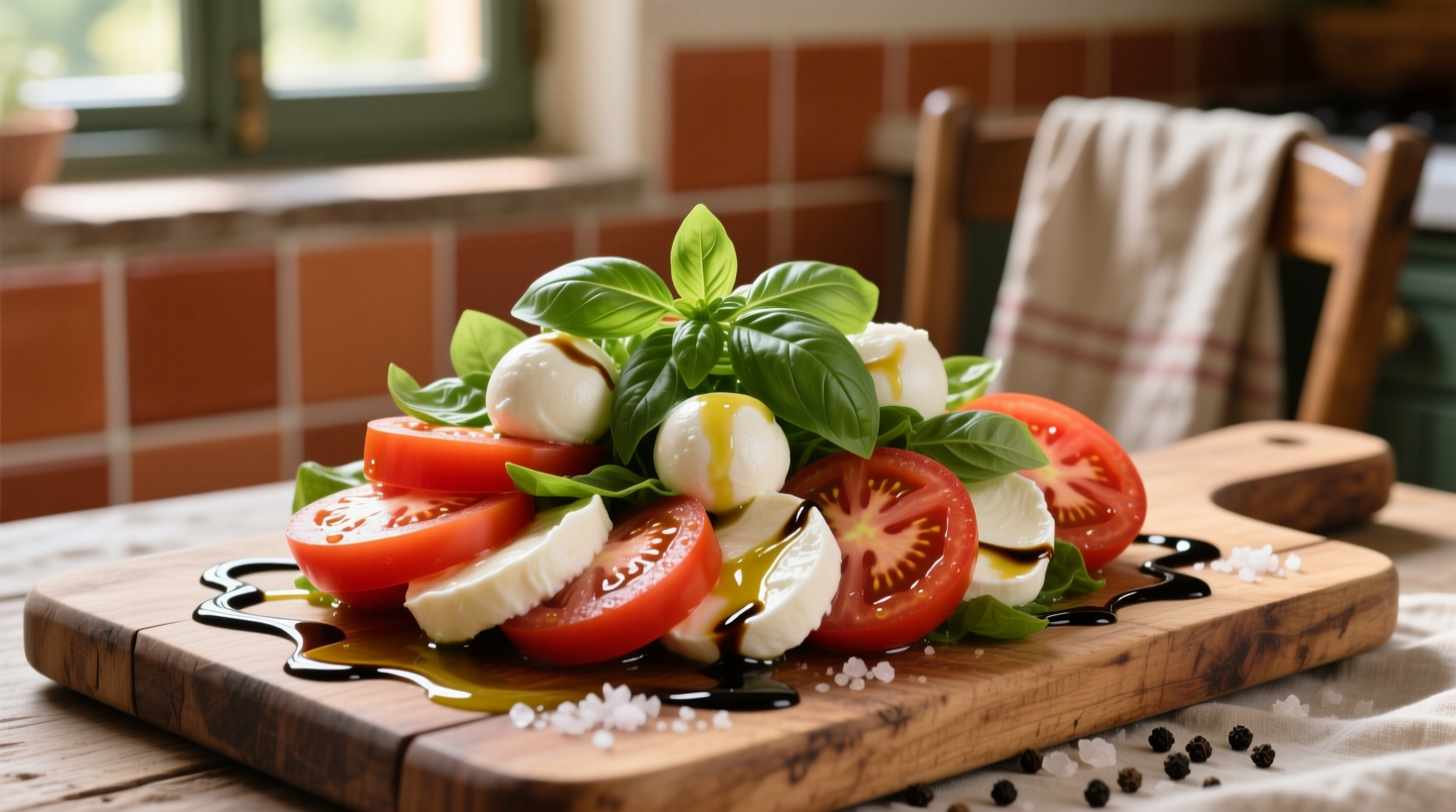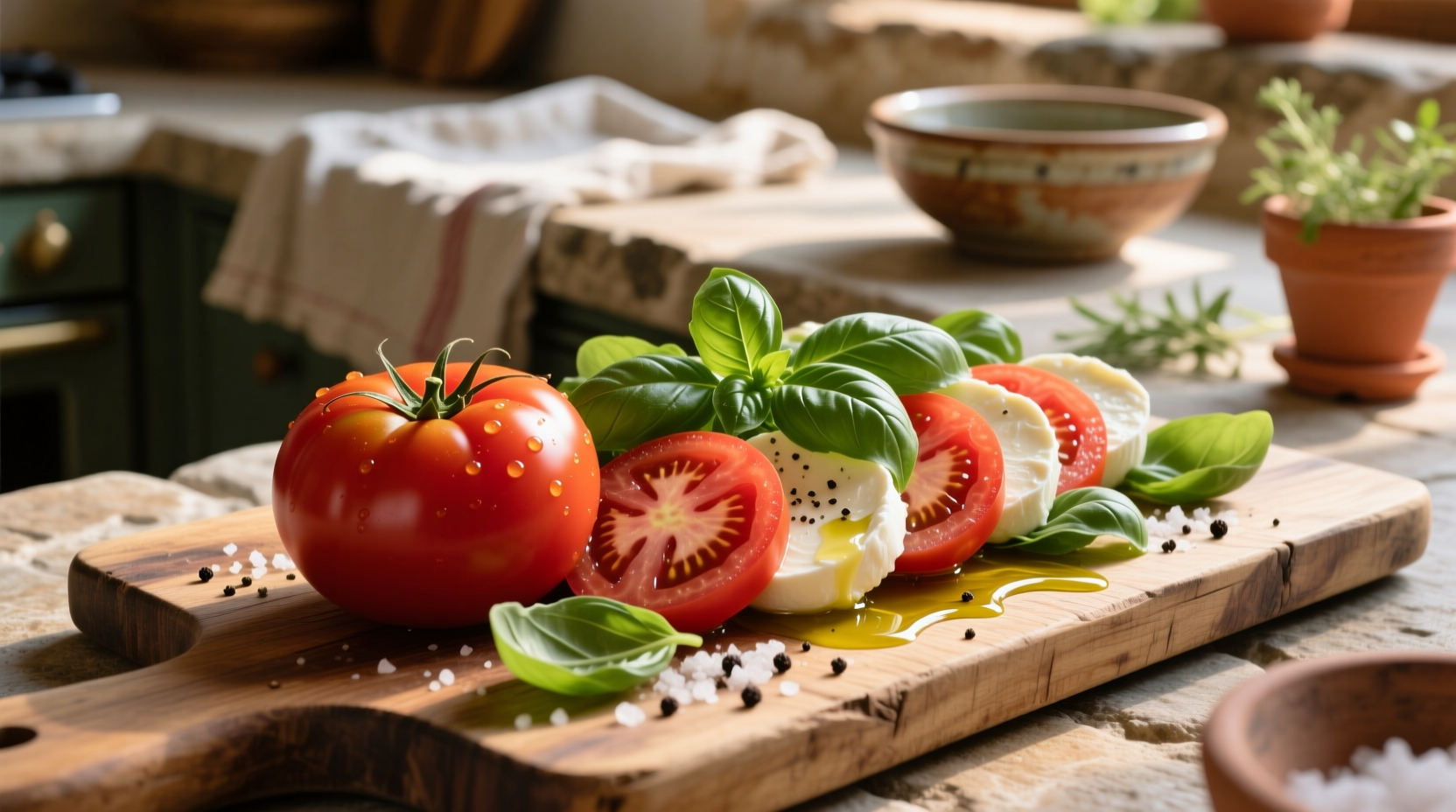Tomato, basil, and fresh mozzarella aren't just ingredients—they're the foundation of Caprese salad, a vibrant Italian classic originating from the island of Capri in the early 20th century. When perfectly executed, this dish delivers a harmonious balance of sweet acidity, herbal freshness, and creamy richness that embodies Mediterranean cooking at its most elegant. Understanding how to select, prepare, and assemble these components properly makes the difference between an ordinary salad and an extraordinary culinary experience.
The Science Behind the Perfect Trio
Food chemistry explains why this combination works so remarkably well. Tomatoes contain glutamates that enhance savory perception, while basil's volatile oils (particularly linalool and eugenol) complement the fruit's natural sugars. Fresh mozzarella's high moisture content (about 50-60%) creates a cooling contrast to the tomato's acidity. According to research from the University of Naples' Department of Agriculture, the optimal ripeness window for tomatoes used in Caprese occurs when lycopene levels peak between July and September—coinciding with basil's most aromatic growth phase.
| Ingredient | Peak Season | Flavor Compounds | Best Variety for Caprese |
|---|---|---|---|
| Tomato | June-September | Lycopene, citric acid | San Marzano or Brandywine |
| Basil | July-August | Linalool, eugenol | Genovese cultivar |
| Mozzarella | Year-round (fresh) | Lactic acid, diacetyl | Fior di Latte or Buffalo |
Ingredient Selection: Quality Indicators You Need to Know
Selecting superior components requires understanding specific quality markers. For tomatoes, look for fruits with deep, uniform color and slight give when gently squeezed—avoid refrigeration as it destroys flavor compounds. The University of California's Agricultural Extension confirms that chilling tomatoes below 55°F (13°C) damages cell membranes, accelerating decay and diminishing aroma.
Fresh mozzarella should feel cool to the touch with a slight springiness, never rubbery. Authentic mozzarella di bufala carries the DOP (Denominazione di Origine Protetta) certification, indicating it's made from water buffalo milk in specific Italian regions. Basil must be vibrant green without yellowing, with leaves that release intense fragrance when rubbed between fingers.

Step-by-Step Assembly: Professional Technique
The order of assembly dramatically impacts flavor integration. Follow this chef-tested sequence:
- Slice tomatoes and mozzarella to uniform 1/4-inch thickness using a serrated knife
- Arrange in alternating overlapping pattern on chilled plate
- Place whole basil leaves between tomato and cheese slices (never chopped)
- Sprinkle with flaky sea salt (like Maldon) immediately to draw out tomato juices
- Drizzle with extra virgin olive oil just before serving
- Add freshly cracked black pepper as final touch
Crucially, never add vinegar or lemon juice—the tomatoes' natural acidity provides perfect balance. The USDA's Food Safety and Inspection Service recommends keeping assembled Caprese at or below 40°F (4°C) until serving to maintain food safety while preserving texture.
Seasonal Considerations and Limitations
While Caprese appears on menus year-round, authentic flavor requires summer-ripened ingredients. Winter tomatoes lack sufficient sugar development (typically below 4.5 Brix), resulting in unbalanced acidity. The Italian Ministry of Agricultural, Food and Forestry Policies documents that traditional Caprese preparation strictly observes seasonal availability, with the dish rarely served before June in authentic trattorias.
Creative Variations That Respect Tradition
While purists insist on the classic formula, thoughtful variations can enhance the experience without compromising integrity:
- Balsamic Reduction Swirl: Use aged 12-year balsamic (never regular vinegar) sparingly
- Herb Infusion: Substitute 20% of basil with fresh oregano or marjoram during summer months
- Cheese Alternatives: Burrata for special occasions (maintains creamy texture)
- Tomato Varietals: Mix heirloom varieties for visual appeal while maintaining similar ripeness
Avoid common pitfalls like using dried basil, pre-sliced 'salad mozzarella,' or adding lettuce—these fundamentally alter the dish's character and texture profile.
Serving and Pairing Recommendations
Caprese shines as both appetizer and light main course. For optimal enjoyment:
- Serve at cool room temperature (60-65°F / 15-18°C)—never chilled
- Pair with crisp Italian white wines like Vermentino or Falanghina
- Complement with crusty bread to capture flavorful juices
- Balance with bitter greens salad if serving as first course
The ideal portion maintains a 2:1 ratio of tomato to cheese by volume, allowing the fruit's acidity to properly cut through the mozzarella's richness. This proportion aligns with traditional Italian serving sizes documented by the Accademia Italiana della Cucina.
Storage and Freshness Preservation
Caprese components require different storage approaches:
- Tomatoes: Store stem-side down at room temperature away from direct sunlight
- Basil: Keep stems in water like flowers, covered loosely with plastic bag
- Mozzarella: Submerged in its liquid in airtight container, consumed within 48 hours
Never assemble Caprese more than 30 minutes before serving—the salt draws moisture from tomatoes, creating a soggy texture if prepared too early. The European Food Information Council confirms that lycopene bioavailability increases slightly when tomatoes are combined with healthy fats like olive oil, making this both delicious and nutritionally beneficial.











 浙公网安备
33010002000092号
浙公网安备
33010002000092号 浙B2-20120091-4
浙B2-20120091-4